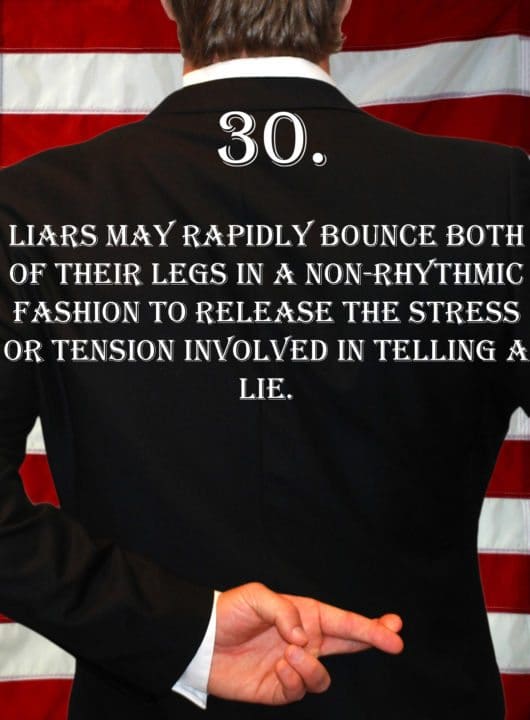
Deception Tip 30:
Liars may rapidly bounce both of their legs in a non-rhythmic fashion to release the stress or tension involved in telling a lie.
Listen To The Podcast!
E30 – Bounce Both Legs – Deception Tips Podcast – Click Here To Subscribe
Podcast Transcript
Hello and welcome to the deception tips podcast, where you will learn amazing cues to detect deceit that will help you read people like never before. I’m your host Spencer Coffman, let’s get started.
Welcome to episode 30 of the deception tips podcast. Today, we are going to talk about a sign of deception that you may not have even known was a sign of deception.
This is something that a lot of people do, and it is considered strange or fidgeting behavior. However, before we get to that, let’s review what we talked about last week.
Last week, we talked about how people can ward off accusations and how they become defensive. This is more of a defensive and a fight or flight response, but it is the flight response of the fight-or-flight, they aren’t going to attack, they are going to retreat. This is a retreating behavior, it was stepping backward. They are fleeing the situation and warding off that accusation by putting their hands in the air.
We also talked about how it doesn’t need to be stepping backward and putting their hands in the air. Obviously, people who are sitting down at a table or at a desk, are not going to be stepping backward at all.
However, they may be leaning backward. In addition to the hand movements, they may not physically raise their hands up above their heads or even with their head or the shoulders or whatever like a stereotypical hand-raising movement.
They may do it on the table or a variation of that where they have their hands parallel to the table and put the palms down and their open fingers spread, something like that. It is a similar gesture of raising hands, but it is in a modified form.
So, like a lot of these gestures, they do get really complex and you need to be watching for variations of each of these gestures. People aren’t always going to step backward, but they may lean back from a situation. People aren’t always going to raise their hands up above their heads.
They may raise their hands in that gesture, but it will be in a different variation. It’s going to fulfill the same purpose, unconsciously, and it is going to appease the conscious and it’ll be a form of leakage. It’s going to have the conscious and the unconscious, they’re going to still be battling it out.
Sometimes, if a situation dictates, the unconscious, as we’ve said is so very, very truthful, and is always pushing to get that truth out. But sometimes the conscious says ha, I’m winning, I’ve seated us in a chair, so we cannot step backward, and we cannot raise our hands.
Yet the unconscious says oh no, I’ve got one better, I’ll just modify this behavior to fit the situation and I’ll put the hands raised but we’re not going to raise them up. I’ll just spread the fingers and open up the palm so they’re parallel to the table, so it does the same thing as raising the hands.
Then the unconscious is satisfied because the leakage occurred and the conscious is satisfied because they’re sitting down, and a big form of leakage didn’t occur. So, they’re still battling, they’re always trying to one-up each other.
I talk about them like they’re two physical people but they’re not, it’s in the same brain but you get the idea, they are trying to one-up each other. They’re fighting back and forth about who is going to leak the truth and who is going to get away with the lie.
The unconscious is always truthful, the truth will always be leaked. It is only if you can train your conscious to start seeing that unconscious leakage, then you will be able to spot lies, read people and detect deception.
So, today we are going to talk about a behavior that is a fidgeting type of behavior. It is something that is typically associated with anxiety or tension and as we’ve talked about before, there is a lot of anxiety and tension in telling a lie.
In addition, there is a lot of stress when people tell a lie and this behavior is great stress relief. I mean, it’s not great stress relief, but it is a way for people to relieve stress. So, when you see this behavior, you’ll know instantly that this person is either under a lot of stress, tension, anxiety, etc.
Now, it’s up to you to determine whether that stress, tension, and anxiety are coming from internal, as in they are telling a lie and they are hoping to get away from it or if it is some other factor like something in the situation. Maybe they are taking a test, maybe they are nervous about their meeting somebody for the first time, you never know. So, that’s why you need to take into account all of the factors in the situation, which can be tough because you may not know that person.
We talked about this a while ago when we spoke of dilated pupils and this was way back in episode number two with how people’s pupils can dilate based on certain situations. Now, by dilating, I’m talking about either they get bigger or they get smaller and it could also be based upon chemical interactions.
So, if people are on some kind of a drug, doesn’t need to be an illegal drug or if they are breathing some kind of fumes, pupils can dilate or the lighting of the room or the area around them can cause the pupils to move.
So, you need to be aware of all of these factors and this can sometimes be difficult. So, for example, someone who is performing this type of stress relief behavior or anxiety behavior, may not know where that anxiety is coming from. However, you can see the anxiety in them.
This is typical of all forms of body language perception that we’ve been talking about and what we are going to talk about is that you may not always know the reason behind the behavior. However, you can know what the behavior means.
So, you’ll be able to see, oh, I can tell you’re anxious about something and they might think well, you’re reading my mind. You would like, no, I just know your body language, I don’t know what’s bothering you.
Sometimes, you can see sadness on people, but you may not know what they’re sad about, you’ll just know they’re sad. It’s up to you to talk to them and to elicit that and say are you ok, you can talk about this, are you comfortable sharing this, or whatever the case may be.
They’re going to kind of feel like you are getting into their head because they don’t know how you can see that because no one else saw it on them or no one else has brought it up. But you can only see the body language, you can’t really see what’s going on inside their head.
So, that is a kind of reassurance to them that you only suspect that something may be going on, but you don’t know what it is. This is the same when we’re detecting deception, we never know what the lie is, that’s why we have to continue to ask questions and watch for further body language. Because we only know that something is happening, a sign of leakage has occurred, we don’t know what that sign is.
So here it is, this is deception tip number 30, liars may rapidly bounce both of their legs in a non-rhythmic fashion to release the stress or tension involved in telling a lie. Here it is again, liars may rapidly bounce both of their legs in a non-rhythmic fashion to release the stress or tension involved in telling a lie.
Now, we are going to talk a lot more about this, I’m really going to break it down and I also want to come back to that we don’t know exactly what everything means in terms of we only know what the behavior means. And all of that is going to happen right after this.
How would you like to really know what every body is saying? Understanding body language can help you in your career, your relationships, and everyday interactions. Subscribe to the deception tips email on spencercoffman.com today.
So, first up, let’s talk about how we don’t know what all of the things are in someone’s head. We only can see the behaviors, so we can see the physical behaviors. For example, in this situation, we can see that someone is rapidly bouncing their legs in a non-rhythmic fashion. Now, we can know that that is a stress or tension release or some form of anxiety. So, then we could say, okay, well something’s bothering them, we don’t know what it is.
However, if it’s final exam day in a college classroom, we can be pretty certain that they are anxious about the test. Or, if they are sitting in the police station waiting to be interviewed, they’re pretty nervous about whatever they’re going to talk about.
Whether they are here to give their statement, as a witness or they are here to be interrogated for a crime, they’re anxious about that situation. You look around a courtroom, someone is going to testify, they’re bouncing their legs, ok, they’re nervous about that. Someone is going to give a speech, maybe they’re nervous about being in front of people.
You can speculate about the outcome of certain situations, but we can never be certain of what is going on in someone’s head. Exactly like If you can see other signs of body language on people, we only know that a certain thing is a deceptive sign, we don’t know what the lie is.
This is why it is important for us to continue to poke and prod and ask further questions and then watch where other signs of behavior come in. Because if you get down a certain path and you’re not seeing anything, take a new path you start seeing something, pull that thread, keep going and watch for signs to continue and then you can kind of find your way to that lie.
And so, with this behavior, bouncing their legs, a lot of times you’ll see it in only one leg. They have one of their legs bouncing up and down like a jackhammer where their heel is off the ground, but the balls of their feet are on the ground and they’re just going bing bing bing bing bing bing bing like a maniac with their leg bouncing up and down.
Now, other times when the stress or anxiety is really there, then they will do it with both legs. And I say non-rhythmically in that they aren’t synchronized, it’ll be like one then the other like a double bass pedal going like a million miles an hour.
Now, I say that as a double bass pedal, keep in mind, if this person is a drummer, they may be just keeping their feet busy as in practicing to continue playing that double bass like a maniac, so it could be for any reason. However, this type of behavior is also pleasing.
Some people do it for a tension release or other times it could provide some sort of gratification, as in not really like a sexual gratification but similar feelings to that. So, they’re doing it as a pleasurable behavior to continue to appease themselves or release some form of tension built up inside their body.
Also, if they’re being questioned, then it is more anxiety stress, but it also depends on the point in the conversation or the point in the situation that it is occurring. So, if they’re in the waiting room and it’s bouncing, this is more of anxiety because they’re anxious about what’s to come.
Now, if they’re in there being talked to or in a conversation and it’s bouncing, this is more of the stress of the situation. So, you can kind of see that based upon where this behavior is occurring, it could mean different things, but in reality, it is all anxiety, stress, tension related behaviors.
If they’re sitting by themselves and this bouncing, it could be they’re thinking about something. They’re anxious about something or it could be that they are doing that behavior because it is a form of release of some kind of tension which in that case, now becomes a pleasurable behavior.
Just like how if you are doing certain other behaviors that release tension and release stress like massaging your neck, that is a release of tension and stress but is also a pleasurable behavior because it’s providing you with some form of satisfaction and relief and you’re like, ah.
So, they may be doing this by bouncing the legs to release some anxiety or release some energy as a way of venting in a socially appropriate way. So, keep in mind that when you see this, it is always going to be some form of stress, tension, or anxiety release.
But the reasons behind it can differ depending on where you see the behavior and where the situation occurs. So, this is why it is important to look for other behaviors and watch and lump them in as a cluster, in a pattern of behaviors, so you can really hone in on why this is happening.
If you can have a little bit of knowledge about the situation, you can see the behavior and say, well, what’s this person doing? Oh, they’re waiting to go in for an exam or they’re doing this or they’re next to give their statement or they’re waiting to go into the courtroom and testify. Then you can have a better idea of why the behavior is occurring without even asking them.
When you talk to them you can know more about that situation which will then either freak them out a lot more because they’ll be like well, how did you know I was waiting for a test or how did you know this was happening?
Or, it will show them that you are very credible and then they may open up to you a little bit more because they’ll be like, wow, you really understand what is going on. So, I feel like I can trust you more because you understand it.
You’re not just talking to me to talk or to get me to talk, you are actually understanding, and they’ll see that you’re on the same level as them. I mean you may not be, but you will be portraying that because you are able to see all of the things that are going on with them.
This is why it is important to make sure that you are looking for further confirmation within the conversation that you are going down the right path. Because if you get further and further in and then all of a sudden you completely mess up, your credibility is going to go way down. Not credibility but your authority and rank with them are going to go way down. You’re going to lose a little bit of face.
So, then what you need to do is bring it back to regain that quickly, so you don’t seem like you’re just a schmuck that’s trying to get in and do whatever you’re doing and then you leave them alone. No, you want them to feel like they can tell you whatever it is so that they will be honest with you. And then when you see these deceptive behaviors, you can bring them out and call them out on those.
Now obviously, not publicly call them out like a jerk, but you’ll bring the conversation towards there so that you are always looking for the truth. And the good news is the unconscious will be on your side and it will continue to leak the truth time and time again. So, if you can start making those behaviors visibly conscious to you, then you will be able to see that on other people as well.
I want to thank you for listening to this week’s episode of the deception tips podcast. I encourage you to share with your friends, subscribe to the feed, take a look at the deception tips videos, follow the seven tips blog and check out the books I have available and as always tune in next week for a new deception tip.
Video Transcript
Hey guys, my name is Spencer Coffman, thank you for watching the deception tips videos. They’re all about teaching you how to detect deception and read people so that you will be able to tell if someone is lying to you.
Today we are going to talk about a sign of deception that is on one of the most expressive areas of the body. We talked about this a while ago in number 22 with crossing the legs in an X fashion. If you remember that then now you know that we’re going to talk about the legs, so I kind of gave it away there but this is another sign on the legs and it is something that you can see, it is a behavior that people do all the time.
Most of the time they may do it without thinking but the reason they do it is the same for everybody. It is to relieve some tension or stress or provide some sort of physical gratification by doing that. They’re relieving some tension, anxiety, stress etc. and also satisfying themselves by doing that. By getting rid of that stress they automatically feel better, by easing that anxiety and that tension they’re feeling better. It’s a dual-purpose sign of deception here and it happens in a lot of areas.
The reason why it could be paired with deception is because when people are lying there under a lot of tension and under a lot of anxiety and under a lot of stress. So, if you see this behavior it doesn’t mean they’re lying, they could be under tension anxiety and stress for another reason. Look around a college classroom on final exam day or on mid-semester tests or quarterly tests or whatever you may see this all over the place.
Now, it doesn’t mean they’re all cheating on their tests they just have a lot of test anxiety. So, here it is, this is deception tip number 30. Liars may rapidly bounce both of their legs in a non-rhythmic fashion to release the stress or tension involved in telling a lie. So, this could happen with people who are lying and with people who are not lying but it is up to you to determine the situation involved and why that person would be getting rid of that stress or tension because that is the same across everybody.
They have stress, tension, anxiety, some form of, let’s just say negative emotion or feeling and they are trying to get it out. By bouncing their legs or leg, it could be a potential they are releasing that tension, stress anxiety, etc. and so why are they doing that, that’s up to you. Are they telling a lie or is it something else?
Now, this can happen in two ways; sometimes you see people, they bounce one leg up and down, up and down like crazy. So, they’re bouncing their leg, it’s when they have their heel off the ground and their foot is resting on the balls of their feet. It’s like their heel isn’t really touching the ground every time but it’s like they’re tapping their foot up and down and it’s crazy, it’s really fast and it’s going up and down like that.
Now, when they’re doing it with one leg this could be a potential sign. However, when they have both legs going non-rhythmically like not at the same time it’s like every other, it’s like a double bass super-fast heartbeat then it could be a pretty sure sign that something is going on. They are under a lot of tension, a lot of anxiety, and a lot of stress, so why is that?
Are they taking a final exam or is there something else going on? Are they trying to hide something? Are they telling a lie? Are they preparing for a lie? What’s happening? That is up to you to figure out. Fortunately, there will be more than one sign, so you can look for other signs of deception because keep in mind they’re seated. So, this could happen, they could be bouncing their legs and then they could realize like, wait a minute this isn’t looking normal and then they may cross their legs and tuck them under their chair.
So, that could be a precursor to what we talked about with crossing the legs because they would cross their legs. Why would they cross their legs? Well, in this instance it’s to keep them from bouncing by locking them together, locking their ankles in that X now they’re tight. Their legs are not going to be bouncing because they’re locked, so the bouncing legs could be a precursor to this.
So, if you see them bouncing their legs then you see them lock their ankles now you have a couple different signs. Actually, a few, because if they were bouncing them then they cross them and lock them and then they put them under the chair, now you’ve got a whole cluster of behaviors. You can watch for other signs because that was only the legs.
Watch for the face, the body, everywhere else, there will always be more signs. So, look for that pattern and that cluster of behavior to determine whether or not the situation is deceptive or whether it is regular and innocent.
If this is your first time watching these videos, I would love to have you subscribe to the channel on YouTube. Feel free to leave any comments or questions there as well. Also, if you’d like some more information, we’ve got books, podcasts, and blog posts all available on spencercoffman.com that are dedicated teaching you exactly what everybody is really saying.
Until next time.






